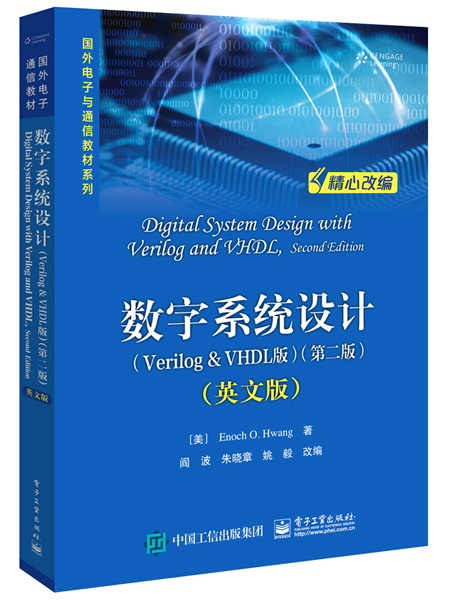《數字系統設計(Verilog & VHDL版)(第二版)(英文版)》是2018年1月電子工業出版社出版的圖書,作者是閻波、朱曉章、姚毅。
基本介紹
- 書名:數字系統設計(Verilog & VHDL版)(第二版)(英文版)
- 作者:閻波、朱曉章、姚毅
- ISBN:9787121334214
- 頁數:420頁
- 定價:79元
- 出版社:電子工業出版社
- 出版時間:2018年1月
- 開本:16開
內容簡介,圖書目錄,
內容簡介
隨著微電子技術與計算機技術的飛速發展,以及先進的電子設計自動化(EDA)技術及現場可程式門陣列(FPGA)器件的廣泛套用,現代數字邏輯電路與系統的設計理念及實現技術已經發生了翻天覆地的變化。本書以微處理器系統作為複雜數字邏輯系統的代表,在簡要介紹其工作原理的基礎上,以CPU硬體結構框圖為線索貫穿各個章節,詳細講述了如何構建基本組合/時序邏輯元件、如何利用已有元件組建數據通路與控制單元部件、如何利用已有部件實現一個通用CPU,以及如何通過進一步添加簡單的輸入輸出接口來最終搭建出一個完整的微處理器系統。本書通過在簡單的數字邏輯元件與複雜的實用數字邏輯系統之間搭建橋樑,能夠幫助讀者深刻理解數字邏輯組件的設計與使用方法,進而全面和清晰地把握複雜數字系統的EDA設計與實現技術要點。本書及相關網站提供了豐富的實用學習資源,所有設計示例都提供了電路圖以及Verilog與VHDL源碼。
圖書目錄
Chapter 1 Introduction to Microprocessor Design
1.1 Overview of Microprocessor Design
1.2 Design Abstraction Levels
1.3 Examples of a 2-to-1 Multiplexer
1.3.1 Behavioral Level
1.3.2 Gate Level
1.3.3 Transistor Level
1.4 Introduction to Hardware Description Language
1.5 Synthesis
1.6 Going Forward
1.7 Problems
Chapter 2 Fundamentals of Digital Circuits
2.1 Binary Numbers
2.1.1 Counting in Binary
2.1.2 Converting between Binary and Decimal
2.1.3 Octal and Hexadecimal Notations
2.1.4 Binary Number Arithmetic
2.2 Negative Numbers
2.2.1 Two’s Complement Representation
2.2.2 Sign Extension
2.2.3 Signed Number Arithmetic
2.3 Binary Switch
2.4 Basic Logic Operators and Logic Expressions
2.5 Logic Gates
2.6 Truth Tables
2.7 Boolean Algebra and Boolean Equations
2.7.1 Boolean Algebra
2.7.2 Duality Principle
2.7.3 Boolean Functions and Their Inverses
2.8 Minterms and Maxterms
2.8.1 Minterms
2.8.2 Maxterms
2.9 Canonical, Standard, and Non-Standard Forms
2.10 Digital Circuits
2.11 Designing a Car Security System
2.12 Verilog and VHDL Code for Digital Circuits
2.12.1 Verilog Code for a Boolean Function
2.12.2 VHDL Code for a Boolean Function
2.13 Problems
Chapter 3 Combinational Circuits 65
3.1 Analysis of Combinational Circuits
3.1.1 Using a Truth Table
3.1.2 Using a Boolean Function
3.2 Synthesis of Combinational Circuits
3.2.1 Using Only NAND Gates
3.3 Minimization of Combinational Circuits
3.3.1 Boolean Algebra
3.3.2 Karnaugh Maps
3.3.3 Don’t-Cares
3.3.4 Tabulation Method
3.4 Timing Hazards and Glitches
3.4.1 Using Glitches
3.5 BCD to 7-Segment Decoder
3.6 Verilog and VHDL Code for Combinational Circuits
3.6.1 Structural Verilog Code
3.6.2 Structural VHDL Code
3.6.3 Dataflow Verilog Code
3.6.4 Dataflow VHDL Code
3.6.5 Behavioral Verilog Code
3.6.6 Behavioral VHDL Code
3.7 Problems
Chapter 4 Standard Combinational Components
4.1 Signal Naming Conventions
4.2 Multiplexer
4.3 Adder
4.3.1 Full Adder
4.3.2 Ripple-Carry Adder
4.3.3 Carry-Lookahead Adder
4.4 Subtractor
4.5 Adder-Subtractor Combination
4.6 Arithmetic Logic Unit
4.7 Decoder
4.8 Tri-State Buffer
4.9 Comparator
4.10 Shifter
4.11 Multiplier
4.12 Problems
Chapter 5 Sequential Circuits
5.1 Bistable Element
5.2 SR Latch
5.3 Car Security System—Version 2
5.4 SR Latch with Enable
5.5 D Latch
5.6 D Latch with Enable
5.7 Verilog and VHDL Code for Memory Elements
5.7.1 VHDL Code for a D Latch with Enable
5.7.2 Verilog Code for a D Latch with Enable
5.8 Clock
5.9 D Flip-Flop
5.9.1 Alternative Smaller Circuit
5.10 D Flip-Flop with Enable
5.10.1 Asynchronous Inputs
5.11 Description of a Flip-Flop
5.11.1 Characteristic Table
5.11.2 Characteristic Equation
5.11.3 State Diagram
5.12 Register
5.13 Register File
5.14 Memories
5.14.1 ROM
5.14.2 RAM
5.15 Shift Registers
5.15.1 Serial-to-Parallel Shift Register
5.15.2 Serial-to-Parallel and Parallel-to-Serial Shift Register
5.15.3 Linear Feedback Shift Register
5.16 Counters
5.16.1 Binary Up Counter
5.16.2 Binary Up Counter with Parallel Load
5.17 Timing Issues
5.18 Problems
Chapter 6 Finite-State Machines
6.1 Finite-State Machine Models
6.2 State Diagrams
6.3 Analysis of Finite-State Machines
6.3.1 Next-State Equations
6.3.2 Next-State Table
6.3.3 Output Equations
6.3.4 Output Table
6.3.5 State Diagram
6.3.6 Example
6.4 Synthesis of Finite-State Machines
6.4.1 State Diagram
6.4.2 Next-State Table
6.4.3 Next-State Equations
6.4.4 Output Table and Output Equations
6.4.5 FSM Circuit
6.5 Optimizations for FSMs
6.5.1 State Reduction
6.5.2 State Encoding
6.5.3 Unused States
6.6 FSM Construction Examples
6.6.1 Car Security System—Version 3
6.6.2 Modulo-6 Up-Counter
6.6.3 One-Shot Circuit
6.6.4 Simple Microprocessor Control Unit
6.6.5 Elevator Controller Using a Moore FSM
6.6.6 Elevator Controller Using a Mealy FSM
6.7 Verilog and VHDL Code for FSM Circuits
6.7.1 Behavioral Verilog Code for a Moore FSM
6.7.2 Behavioral Verilog Code for a Mealy FSM
6.7.3 Behavioral VHDL Code for a Moore FSM
6.7.4 Behavioral VHDL Code for a Mealy FSM
6.8 Problems
Chapter 7 Dedicated Microprocessors
7.1 Need for a Datapath
7.2 Constructing the Datapath
7.2.1 Selecting Registers
7.2.2 Selecting Functional Units
7.2.3 Data Transfer Methods
7.2.4 Generating Status Signals
7.3 Constructing the Control Unit
7.3.1 Deriving the Control Signals
7.3.2 Deriving the State Diagram
7.3.3 Timing Issues
7.3.4 Deriving the FSM Circuit
7.4 Constructing the Complete Microprocessor
7.5 Dedicated Microprocessor Construction Examples
7.5.1 Greatest Common Divisor
7.5.2 High-Low Number Guessing Game
7.5.3 Traffic Light Controller
7.6 Verilog and VHDL Code for Dedicated Microprocessors
7.6.1 FSM1D Model
7.6.2 FSMD Model
7.6.3 Algorithmic Model
7.7 Problems
Chapter 8 General-Purpose Microprocessors
8.1 Overview of the CPU Design
8.2 The EC-1 General-Purpose Microprocessor
8.2.1 Instruction Set
8.2.2 Datapath
8.2.3 Control Unit
8.2.4 Complete Circuit
8.2.5 Sample Program
8.2.6 Simulation
8.2.7 Hardware Implementation
8.3 The EC-2 General-Purpose Microprocessor
8.3.1 Instruction Set
8.3.2 Datapath
8.3.3 Control Unit
8.3.4 Complete Circuit
8.3.5 Sample Program
8.3.6 Hardware Implementation
8.4 Extending the EC-2 Instruction Set
Chapter 9 Interfacing Microprocessors
9.1 Multiplexing 7-Segment LED Display
9.1.1 Theory of Operation
9.1.2 Controller Design
9.2 Issues with Interfacing Switches
9.3 3×4 Keypad Controller
9.3.1 Theory of Operation
9.3.2 Controller Design

